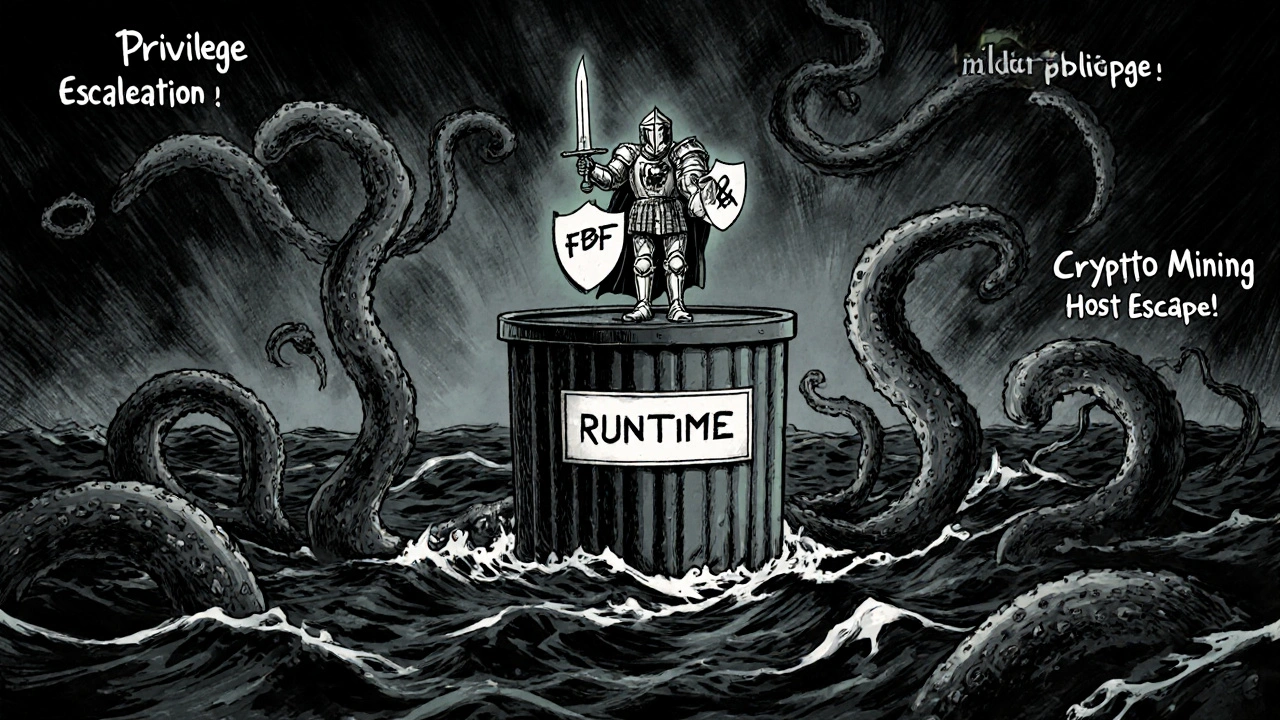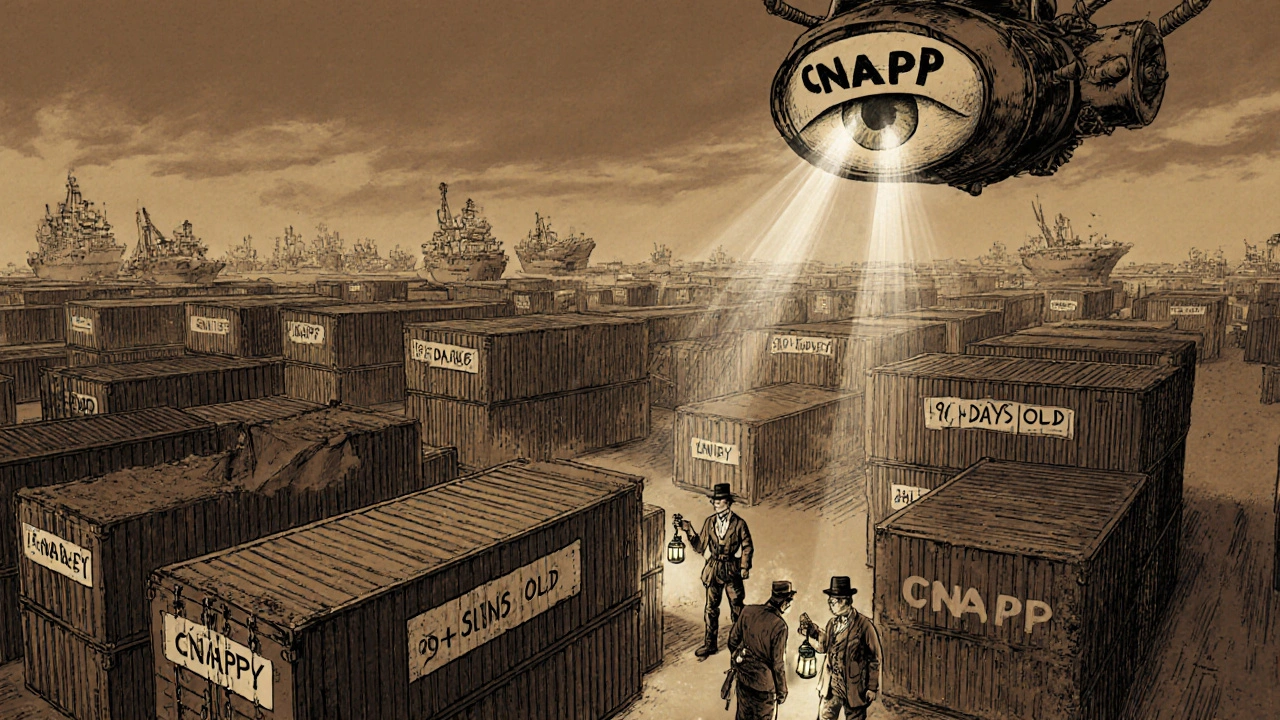Containers are fast. They deploy in seconds, scale on demand, and let teams ship code faster than ever. But speed doesn’t mean safety. If you’re running containers in production without checking what’s inside them or how they behave once they’re up, you’re just asking for trouble.
Why Container Security Isn’t Optional Anymore
Containers aren’t just lightweight VMs. They’re self-contained packages of code, libraries, and configs that run on top of a shared OS. That means if one container gets compromised, it can potentially reach others-or even the host system. A single vulnerable image, a misconfigured permission, or a hidden secret key can become a backdoor into your entire infrastructure.
Companies like Instagram, Netflix, and Spotify run thousands of containers daily. They don’t rely on luck. They rely on two non-negotiable layers: image scanning before deployment, and runtime controls while the container is live. Skip one, and you’re leaving a gap attackers will find.
What Is Container Image Scanning?
Image scanning is your first line of defense. It happens before a container ever starts. Tools examine the container image-built from layers like a base OS, your app code, and all the dependencies-to find known problems.
Here’s what they look for:
- Vulnerabilities: Outdated packages with public CVEs (like OpenSSL 1.1.1g with CVE-2020-1971)
- Malware: Hidden scripts, cryptominers, or backdoors buried in layers
- Secrets and keys: API tokens, passwords, or SSH keys accidentally baked into the image
- Compliance violations: Images built from unapproved base OS versions or violating internal policies
Scanners work by pulling the image from your registry-Docker Hub, Harbor, Amazon ECR-and breaking it down layer by layer. They compare every package against databases like the National Vulnerability Database (NVD) or proprietary threat feeds. A signature-based scanner checks for known patterns. A behavior-based one might flag odd file structures or unusual binaries even if they don’t match a known CVE.
For example, if your image includes Python 3.8.10 with a known RCE flaw (CVE-2021-3426), the scanner will flag it. You’ll see the exact package, version, and risk level. Then you rebuild the image with Python 3.8.18-no patching, no guesswork.
How Image Scanning Fits Into Your CI/CD Pipeline
Scanning shouldn’t be a manual step. It has to be automatic. If your team waits until staging to scan, you’ve already wasted hours of work.
Best practice: Integrate scanning right after your container build step in CI/CD. Tools like Trend Micro Application Security (TMAS), JFrog Xray, or Trivy (open-source) can be triggered by Git commits. If the scan finds a critical vulnerability, the pipeline stops. No image gets pushed to production.
Some teams worry this slows things down. But modern scanners run in seconds. And the cost of a breach? Millions. According to Trend Micro, teams using integrated scanning reduce production vulnerabilities by up to 70% within six months.
Pro tip: Don’t just scan new images. Schedule weekly scans of your entire registry. Old images left lying around are the most common attack vectors. A 2023 Wiz report found that 42% of exploited containers ran images over 90 days old.

What Happens After the Container Starts? Runtime Controls
Even a perfectly scanned image can turn dangerous once it’s running. Why? Because runtime behavior matters more than static content.
Runtime security watches what containers do while they’re alive. It’s like having a security guard inside your server room, watching every move.
Here’s what it monitors:
- Anomalous patterns: A web server suddenly making outbound connections to a crypto mining pool
- Privilege escalation: A process inside a container trying to run sudo or access /etc/shadow
- Configuration drift: A container that was started with read-only filesystems suddenly gets remounted as writable
- Insecure data access: A container reading files outside its intended directory
- Host vulnerabilities: A container exploiting a kernel flaw to escape its sandbox
Tools like Falco (open-source), Sysdig Secure, and Prisma Cloud use eBPF to tap into the Linux kernel. They monitor system calls in real time-things like open(), exec(), socket(), and connect(). If a container tries to do something outside its normal behavior, the tool triggers an alert.
For example, Falco can be configured to alert if any container makes an inbound network connection on port 22 (SSH) that wasn’t expected. You write rules in YAML: “alert if container, inbound, not trusted”. It’s not about blocking everything-it’s about knowing what’s normal so you can spot what’s not.
How Runtime Controls Block Threats Before They Spread
Runtime security doesn’t just alert-it acts. Most platforms let you define policies that automatically stop bad containers.
Here’s how it works in practice:
- A container starts running with a hidden miner inside (missed during scanning because it was obfuscated)
- Within seconds, it starts making outbound connections to a known malicious IP
- The runtime tool detects the unusual network activity
- It triggers a policy: “block any container making outbound connections to blacklisted domains”
- The container is immediately isolated and killed
- Security teams are notified with full forensic data: which container, what system calls, when it happened
This happens in under a second. No human needs to respond. No alert gets buried in a Slack channel.
Integration with Kubernetes is key. Tools like Trend Micro and Prisma Cloud connect directly to the Kubernetes API server. When a deployment YAML is submitted, an admission webhook checks the image against scan results and runtime policies. If it fails? The deployment is blocked before it ever touches your cluster.
Open Source vs. Commercial Tools
You don’t need to spend millions to get started.
Open source: Falco is the most popular runtime tool. Trivy is great for image scanning. Both are CNCF-accepted, actively maintained, and free. But they require setup, tuning, and ongoing maintenance. Falco rules can generate false positives if not fine-tuned. You’ll need engineers who understand Linux internals.
Commercial: Tools like Aqua Security, Sysdig, Prisma Cloud, and JFrog offer pre-built policies, dashboards, compliance reports, and 24/7 support. They integrate with CI/CD, Kubernetes, and cloud platforms out of the box. They’re more expensive but save time and reduce risk for teams without deep security expertise.
Many organizations start with open-source tools for scanning and use commercial platforms for runtime protection. Others use a hybrid: Trivy in CI/CD, Falco in production, with alerts sent to a central SIEM.

Best Practices for Real-World Implementation
Here’s what actually works in production:
- Always run containers as non-root users. If your app doesn’t need root, don’t give it root. This alone blocks 80% of container escapes.
- Use read-only filesystems where possible. If your app doesn’t need to write to disk, lock it down.
- Scan every image, every time. No exceptions. Even internal tools.
- Scan registries weekly. Old images are low-hanging fruit.
- Integrate scanning into CI/CD. Make it automatic, not optional.
- Use policy-based runtime controls. Don’t just monitor-enforce.
- Keep your base images minimal. Use distroless or Alpine images instead of Ubuntu or CentOS unless you need the full OS.
- Rotate secrets regularly. Never bake them into images. Use Kubernetes Secrets or HashiCorp Vault instead.
One team at a mid-sized SaaS company reduced container incidents by 90% in three months by doing just these five things: scanning in CI/CD, blocking root containers, using read-only filesystems, scanning registries weekly, and enabling Falco with default rules.
The Future: CNAPP and Beyond
Container security is no longer a standalone tool. It’s part of Cloud-Native Application Protection Platforms (CNAPP). These platforms combine container security with workload protection, cloud infrastructure scanning, and identity controls-all in one dashboard.
Expect more automation: AI-driven policy suggestions, self-tuning anomaly detection, and auto-remediation for low-risk issues. But the core won’t change: scan before you run, monitor while you run. That’s the only way to keep up with the speed of containers without sacrificing security.
Do I need both image scanning and runtime controls?
Yes. Image scanning catches problems before deployment-like outdated packages or exposed secrets. Runtime controls catch what scanning misses: malware that hides until execution, privilege escalation attempts, or abnormal behavior. One protects the container’s contents; the other protects its behavior. Together, they cover the full lifecycle.
Can I use open-source tools for production?
Absolutely. Falco and Trivy are used by Fortune 500 companies. But they require expertise to configure properly. If your team lacks security engineers or time to tune rules, commercial tools reduce risk faster. Start with open-source to learn, then upgrade when you need automation, support, and compliance reporting.
How often should I scan container images?
Scan every time you build a new image. Also, schedule weekly scans of all images in your registry. New vulnerabilities are discovered daily. An image that was safe last month might be dangerous today because of a new CVE. Automated registry scanning is non-negotiable.
What’s the biggest mistake teams make with container security?
Assuming scanning is enough. Many teams scan images, think they’re secure, and move on. But runtime threats-like a compromised container making outbound calls or escalating privileges-can’t be caught by static scans. You need active monitoring. The most common breach happens after deployment, not before.
Does container security slow down CI/CD pipelines?
Not if done right. Modern scanners like Trivy or TMAS take under 30 seconds per image. That’s faster than running tests in many pipelines. The slowdown isn’t from scanning-it’s from fixing issues you didn’t know about. The real delay comes from deploying vulnerable code and having to roll it back. Scanning saves time in the long run.
How do I know if my runtime controls are working?
Test them. Use tools like Chaos Mesh or custom scripts to simulate attacks: try to exec into a container as root, make an outbound connection to a known malicious domain, or write to a read-only filesystem. If your system detects and blocks it, you’re good. If not, your rules need tuning. Regular red-team exercises are the best way to validate security controls.
What to Do Next
Start small. Pick one container registry. Pick one critical application. Integrate Trivy into its CI/CD pipeline. Set up Falco on your Kubernetes cluster with default rules. Watch the alerts. Tune the false positives. Then expand.
Don’t try to secure everything at once. Secure one thing well, then add more. The goal isn’t perfection-it’s progress. Every container you scan and monitor is one less risk in your environment.







Comments
Kenny McMiller
October 30, 2025Look, containers are just glorified chroot jails with extra steps. The real issue isn’t scanning or runtime controls-it’s that we’ve outsourced our operational responsibility to tooling. You think Falco’s gonna save you when your dev team still builds images from ubuntu:latest with sudo baked in? Scanners are just fancy grep scripts with a UI. The only thing that matters is culture: if your org doesn’t treat security like a shared muscle, not a checkbox, you’re already pwned.
And don’t get me started on CNAPP. It’s just vendor lock-in with more buzzwords. You don’t need a $500k platform to block root containers. You need a git hook that runs `docker run --rm --user 65534` and screams if it doesn’t pass. Simplicity wins. Always.
Dave McPherson
October 30, 2025Wow. Another ‘container security’ manifesto from someone who thinks Trivy is a wizard. Let me guess-you’ve never actually seen a real container escape in the wild, have you? You’re out here treating CVE databases like holy scripture while the real threats are zero-days hiding in glibc patches that won’t even show up in NVD for another 90 days.
And don’t even get me started on ‘read-only filesystems.’ That’s like wearing a helmet while skydiving but forgetting to pack a parachute. If your app needs to write logs, config files, or temp data-good luck with that ‘secure’ setup. You’re just creating brittle, broken deployments that crash every time someone tries to actually use them.
Also, Falco? Cute. It’s basically a Linux syscalls echo chamber with 80% false positives. I’ve seen teams waste weeks tuning it only to disable it because it ‘got in the way.’ Real security isn’t about monitoring every syscall-it’s about not letting untrusted code run in the first place. Maybe try AppArmor? Or better yet-don’t run containers at all. Virtual machines are still a thing, you know.
And ‘distroless’? That’s just Docker’s way of saying ‘we don’t care what’s in your image, just don’t tell us.’
Stop selling snake oil. The real answer? Run less stuff. Simpler systems have fewer attack surfaces. But hey, if you wanna keep buying SaaS dashboards and calling it ‘security,’ be my guest. I’ll be over here actually shipping software.
Julia Czinna
October 31, 2025There’s a lot here worth unpacking, and I appreciate the practical tone. I’ve seen teams get so focused on scanning that they forget runtime behavior is where the real drama happens. One thing I’d add: even with perfect tooling, the human layer is still the weakest link. A dev who ignores a critical CVE because ‘it’s just a dev environment’-that’s the gap that gets exploited.
For us, starting with Trivy in CI and Falco in staging was the right move. We didn’t try to boil the ocean. We picked one app, fixed the low-hanging fruit, and built trust in the system before scaling. The alerts were noisy at first, but we used them to train the team-not punish them.
Also, the point about old images is spot on. We found a container from 2022 still running in production that had a CVE patched two years ago. No one remembered it existed. Weekly scans saved us from a quiet disaster.
Open source tools absolutely work. But they need time, attention, and a little patience. You don’t need a fancy dashboard to sleep better at night-just consistency. And maybe a coffee. Always a coffee.
Write a comment